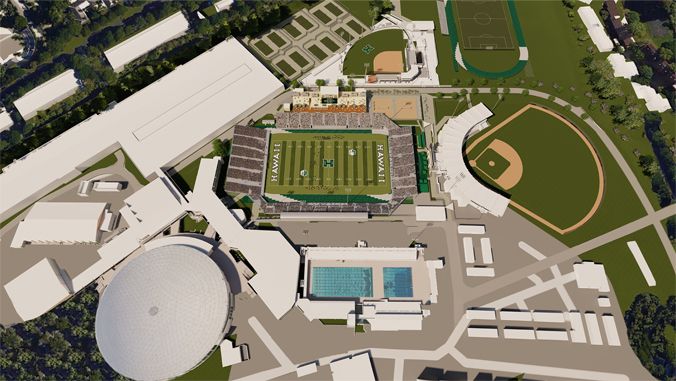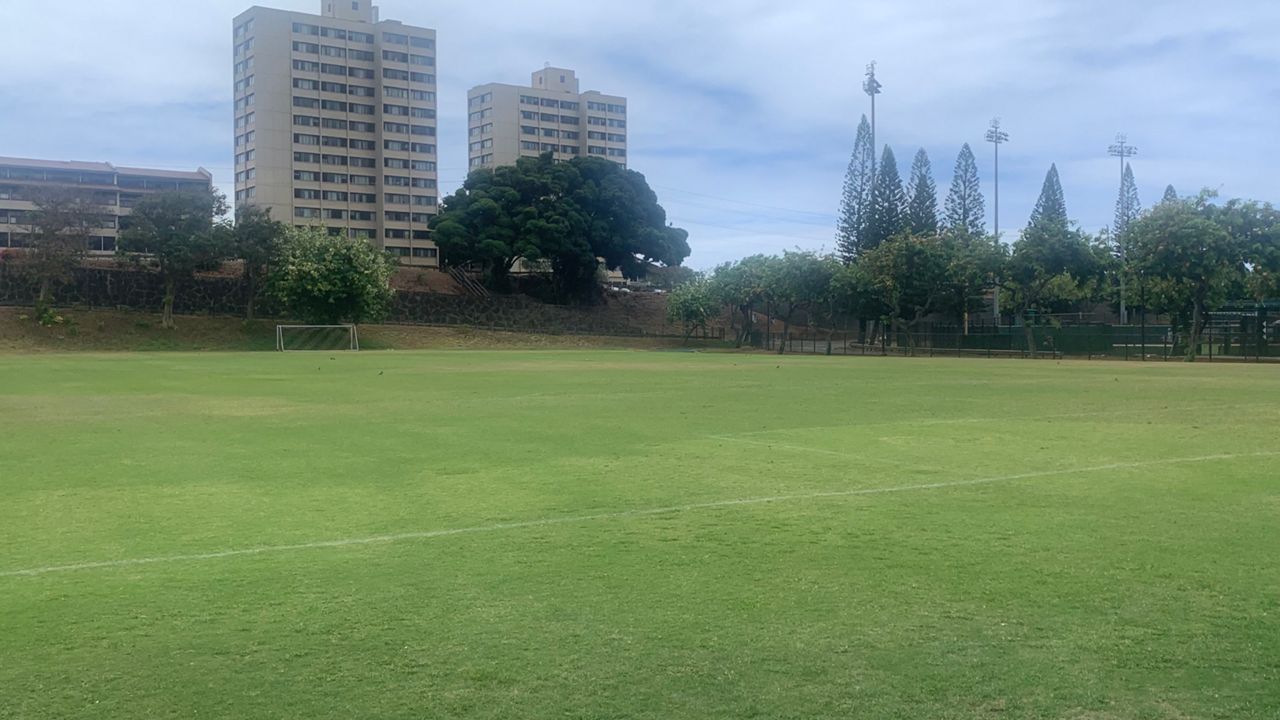HONOLULU — When the Hawaii soccer team opens up its 2022 home schedule at the Waipio Peninsula Soccer Complex on Thursday night, the Rainbow Wahine do so with the knowledge that their days at their longtime venue are numbered.
UH still has to solve for exactly what that figure is, but what's known is that the school intends to construct a new on-campus facility for its soccer and track and field programs as part of a $30 million plan to expand and upgrade the Clarence T.C. Ching Athletics Complex for football games.
UH’s respective soccer and track coaches, Michele Nagamine and Tim Boyce, told Spectrum News they are enthusiastic about the development, even while acknowledging there will be an up-front logistical hurdle for their programs soon after work on the Ching Complex begins in January. UH is expending roughly $15 million to import Aloha Stadium's video scoreboard and to construct additional seating upon the ground where the track currently surrounds the football field.
The second phase of the plan, accounting for roughly another $15 million, calls for the two-tiered grass area known collectively as Cooke Field to be leveled before a new soccer field, surrounded by a track, is built on site. UH announced that it plans for seating of 1,200 for the new venue, which is slated for full availability for track and field, and partial availability for soccer, in May 2024.
A rendering released by UH shows the soccer field and track running mauka-makai, perpendicular to the east-west heading of Ching Complex. The mauka tier of Cooke Field, which is about 10 feet higher than the lower tier, must be excavated and a retaining wall put in place. Drainage and irrigation systems will be installed underneath the soccer field.
Both the soccer and track programs will likely have to arrange for off-campus practices at other schools or sites for at least a year once construction commences sometime next spring.

Here’s an overall look at how the programs will be impacted:
SOCCER
While the Rainbow Wahine have played games at Waipio for nearly the entire existence of the program — the facility opened in 2000 and UH’s Division I soccer started in 1994 — they’ve just about always practiced on campus, at the site of the future field.
UH (0-1), which had a game at Arizona State canceled due to inclement weather over the weekend, opens its seven-game home schedule against Seattle University at 7 p.m. Thursday.
As always, Nagamine and her staff will budget extra time to load up the team vans and drive 17 miles west to Waipio, which is maintained by the City and County of Honolulu. UH, a state institution, attains permits to play there every year.
Nagamine said she enjoys playing at Waipio, which she called a “beautiful complex.” Its stadium is the 4,500-seat crown jewel of 23 playable fields upon which Oahu youth soccer thrives.
And yet …
“I think the end reward is going to be well worth even a temporary displacement, if we were going to have to move off campus or do something to that effect,” said Nagamine, who is in her 12th year with the program. “It would be, in my opinion, 100% worth it in the long run if it meant that we would get to play on campus and our student-athletes have that true student-athlete experience. … They’re not leaving three hours prior to kickoff.”
Nagamine said she would have a role in submitting suggestions for the new field, but she didn’t want to get too ahead of herself.
“I do understand the odds of it happening are a lot greater now that we’ve gotten some support and everything’s out there on the table, but I know there’s a lot of hurdles that need to be cleared,” she said.
While the new soccer field is expected to be usable as a practice site upon the project’s completion in 2024, it will take a few extra steps to make the site playable for an NCAA game.
“The next phase, you have to have lights, media, and a ticket office,” Athletic Director David Matlin told Spectrum News. “(That’d be) for the next step that’s not part of this scope. The good part for soccer is they can play at Waipio until they come back. This puts us in position to make that happen.”
There is not yet a projected date for games on campus, he said.
Sophomore forward Krista Peterson, who had UH’s goal in a 3-1 season-opening loss at Grand Canyon, might not be around to see that.
“Waipio’s a great place to play on, but I think it’s something special about bringing it home, being able to get a lot of the student body over here,” Peterson said at UH Lower Campus this week. “Let’s be realistic — it’s hard to moped to Waipio. I’m excited for the future generations of UH soccer to be able to play with everyone in front of them at home. I think that’s going to be really special.”
TRACK & FIELD
The UH track and field program practiced and held meets on the old rainbow-themed track at the Ching Complex for 17 years, to the point that it had thoroughly degraded and was badly in need of a replacement. The Rainbow Wahine finally got a brand-new green-and-grey surface in 2019, and in March 2020 UH was on the cusp of hosting its first meet between NCAA Division I programs in years.
The only problem was, it was also the cusp of pandemic lockdowns in the state. San Jose State took off on a flight to Honolulu, expecting to compete. But when the Spartans deplaned in the islands, they learned that the meet was canceled.
Boyce is still awaiting the day his program can pick up from that point; the domino effects of the shutdown of Aloha Stadium and relocation of the football program to Ching put that date further down the line.
“Big picture, it’s going to allow us to contend for championships in the conference and recruit at an even higher level than we’ve been able to in the past (near) decade that I’ve been here at UH,” Boyce said.
He said a new track surface will likely be used; he didn’t think it was feasible to relocate the three-year-old surface from Ching. Ideally, he’d like to see multiple horizontal jump runways, and specific areas for the high jump and pole vault, as UH has now at Ching.
But the UH will have to be creative with its new venue in how it allocates space for throwing events like discus, shot put, javelin and hammer, which are currently done in a corner of the grass field where UH soccer practices. Having those objects impact on the level surface of a regulation soccer field would not be ideal for maintenance.
If it’s done right, the intervening years of pandemic and football relocation will have been worth it, said Boyce, whose vision is still to make it a destination for track and field events from youths to college to Team USA.
UH, meanwhile, has been competitive in track in the Big West for the last two seasons. Its second-place finish in the BWC spring championships was its highest ever.
“This is really an unprecedented level of support that the team and program has been shown,” Boyce said. “Yes, there will be some short-term challenges, but bottom line I think it will be great for the sport of track and field and the state of Hawaii.”
Brian McInnis covers the state’s sports scene for Spectrum News Hawaii.



